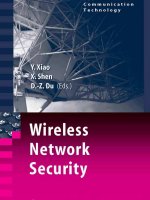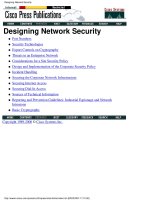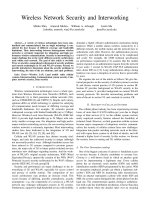White Paper – Wireless Network Security doc
Bạn đang xem bản rút gọn của tài liệu. Xem và tải ngay bản đầy đủ của tài liệu tại đây (127.57 KB, 5 trang )
White Paper – Wireless Network Security
By Scott Akrie
Introduction
One of the most frequently asked questions put to a wireless broadband service provider by their
subscribers is, "what about security?" It is indeed wise for subscribers to be concerned about
security, on any type of network. Disgruntled former employees, hackers, viruses, Internet-based
attacks, and industrial espionage are an unfortunate fact of life in any form of networking today.
This white paper addresses the similarities and differences between security on wire-line and
wireless networks, threats to the security of any network, and those elements unique to wireless
technology used by SkyRiver available to combat these potential threats.
Similarities and Differences Between Wire-Line and Wireless Networks
Common questions from those considering broadband wireless service often revolve around
security. While these concerns are sensible, valid and justified, it is ironic that users rarely ask
these question with the same level of concern about their wire-line network services. The
security of information on the wire is, perhaps incorrectly, assumed as a given. Many have
images of data on a wireless network floating freely in the air waiting for someone with a
scanner to capture it, and as data packets begin traveling through the air, a high degree of anxiety
sets in. After all, it is reasoned, the wire-line network is secure and the data stays on the wire,
only available to authorized users with physical connections to that wire.
A wireless network has all of the properties of a wire-line network (except, of course, the wire),
and thus security measures taken to ensure the integrity and security of data in the wire-line
network environment are applicable to wireless networks as well. The primary difference
between a wire-line network and a wireless network is at the physical layer (wire versus
airspace) and all other network strengths and weaknesses remain.
With the advent of wireless broadband service, wireless service providers and equipment
manufacturers have included an additional set of unique security elements that are not available
in the wire-line world. Based on these elements, the argument can easily be made that wireless
networks are at least as secure as wire-line networks.
Threats to Network Security
Any network, wireless or wire-line, is subject to substantial security risks and issues. These
include:
• Threats to the physical security of a network
• Unauthorized access
• Privacy
© SkyRiver Communications, Inc. 2001 Page 1
Physical Security
. Given the obvious reliance of wire-line networks on the wire, anyone
gaining access to that wire can damage the network or compromise the integrity and
security of information on it. Without the proper security measures in place, even
registered users of the network may be able to access information that would otherwise
be restricted. Disgruntled current and ex-employees have been known to read, distribute,
and even alter valuable company data files. Network traffic can be intercepted and
decoded with commonly available software tools once one has physical access to the
network cabling. In a wire-line network including cable systems, countless cases have
been documented of wiretapping, hacking by authorized users and even people down the
street hacking into their neighbor’s computers.
Subscribers, regardless of whether or not they have wireless segments on their networks,
need to have the appropriate security products for their environments, the proper security
levels set for their users, and an on-going process to audit the effectiveness of security
policies and procedures. Physical access to network wires needs to be protected.
Unfortunately, the vast amount of wire inherent in most networks provides many points
for unauthorized access.
Unauthorized Access
. Another area of concern for security-conscious subscribers is the
growing use of the Internet. Often, if users from inside can get out to the Internet, then
users from outside can get into a network if proper precautions haven't been taken. And
this applies not only to the Internet, but also to any remote network access capabilities
that might be installed. Remote access products that allow traveling sales and marketing
people to dial in for their email, remote offices connected via dial-up lines, intranets, and
"extranets" that connect vendors and customers to a network can all leave the network
vulnerable to hackers, viruses, and other intruders. Firewall products offering packet
filtering, proxy servers, and user-to-session filtering add additional protection.
Many products are available to help subscribers secure their networks from the above
threats. User authentication and authorization is provided by most network operating
systems, and can be enhanced by adding third-party products.
Privacy
. Perhaps the most difficult threat to detect is someone just looking at (and likely
copying) raw data on the network. Wire-line networks are particularly vulnerable to
eavesdropping. Most Ethernet adapters on the market today offer a "promiscuous mode"
that, with off-the-shelf software, enables them to capture every packet on the network.
Most network administrators have some kind of "packet sniffer" and/or network traffic
analyzer for trouble-shooting the network. Inexpensive and readily available hardware
and software let anyone with physical access to the network to read, capture, and display
any type of packet data on the net.
While data encryption is the only line of defense against this kind of threat unfortunately,
no wireline network service provider incorporates this technology as even an option that
subscribers could use with their product.
© SkyRiver Communications, Inc. 2001 Page 2
Security on SkyRiver’s Wireless Network
We can see clearly that data security considerations impact the entire network architecture. And
while these data security considerations apply equally to wireless networks, the technology used
in the physical layer (airspace) of wireless networks actually increases overall network security,
as follows:
Spread Spectrum Technology
. SkyRiver’s wireless networks use a form of spread-
spectrum radio transmission technique. Spread spectrum technology was first introduced
about 50 years ago by the military with the objective of improving both message integrity
and security. Spread-spectrum systems are designed to be resistant to noise, interference,
jamming, and unauthorized detection.
Spread spectrum communications is a means of transmitting a signal over a much wider
frequency bandwidth than the minimum bandwidth normally required to transmit the
information. The minimum is for the spread spectrum to have a bandwidth of at least 10
times the information bandwidth.
A typical radio signal contains both the data itself (which is the useful content) and a
carrier frequency, which is modulated or blended with the data signal in order to "carry"
the transmission across the operating range of the transmitter.
In SkyRiver’s Direct Sequence Spread Spectrum (DSSS) transmissions, another element
is introduced called a pseudo-noise (PN) code sequence. This is a binary – and hence
digital – code sequence which, when modulated with the carrier frequency and original
content, causes the resultant signal to spread across a much wider frequency spectrum,
whereas the original radio signal would have occupied only a specific radio frequency.
This has the resultant effect of dissipating the signal intensity over a broad range of
frequencies, thus shrouding the transmitted signal, and making it indistinguishable from
random white noise.
At the receiver end, in a process known as "correlation", a similar pseudo-noise code
sequence matching exactly the one used by the transmitter is generated in order to
"decode" the transmission by reconstituting the spread spectrum signal into intelligible
information again. Naturally, without this code sequence, the spread spectrum signal is
useless.
Therein lies the security-enhancing feature of DSSS transmissions, which explains why
there is military interest in the technology. Because DSSS transmissions are harder to
detect, there is a lower probability of interception. Because it does not occupy specific
radio frequencies, it is harder to jam. And because it employs binary code sequences to
"encrypt" the transmitted data, it makes it hard for unauthorized parties to "listen in", or
to spoof or imitate network members.
Finally, SkyRiver’s DSSS equipment incorporates the use of optional encryption. The
IEEE 802.11 standard, under which SkyRiver operates, includes a security technique
© SkyRiver Communications, Inc. 2001 Page 3
known as "wire-line equivalent privacy" (WEP), which is based on the use of 64-bit keys
and the popular RC4 encryption algorithm. Users without knowledge of the current key
(password) will find themselves excluded from network traffic. Encryption, as noted
above, is always advisable on any network, and is certainly easier to implement in
wireless networks than in their wire-line counterparts. In addition to WEP, SkyRiver has
the ability to support DES, IDEA and Blowfish as well as a proprietary version of
encryption.
Station Authentication
. SkyRiver’s wireless network like most wireless networks, has
the ability, through an authentication management function, to specifically authorize or
exclude individual wireless stations. Thus an individual wireless user can be included in a
network, or, at any time, locked out. Stations also need to know a wide variety of
information, including radio domains, channels (specific frequencies) as well as IP
addresses and subnets in order to access the network. Thus unauthorized network access
becomes very difficult even for hackers who possess the equipment to attack the
SkyRiver network.
Physical & Network Security
. SkyRiver’s network elements are in secure locations
with environmental controls (including but not limited to remotely monitored intrusion
alarms). These equipment rooms require specific authorization for access. Moreover,
since the access points used in wireless network function as routers, individual wireless
subscribers are isolated from the majority of network traffic. Network subscribers are
unable to gain IP access to any network elements again limiting the possibility of network
penetration or access to raw network packets.
VPN
. It is a commonly accepted fact that Internet technologies have changed the way
that companies disseminate information to their customers, partners, employees, and
suppliers. Initially, companies were conservative with the information they published on
the Internet – product information, product availability and other less business critical
items. More recently, using the Internet as a means of providing more cost effective
access to business critical information such as order status, inventory levels, or even
financial information has gained wider acceptance through Virtual Private Networks or
VPNs. A Virtual Private Network is a business solution that provides secure, private
connections to network applications using a public or "unsecured" medium such as the
Internet. With a VPN deployed across the Internet, virtual private connections can be
established from almost anywhere in the world.
While subscribers currently have the capability to implement VPNs on their network
through external CPE, SkyRiver will soon have the ability to offer an integral VPN
option in its network.
Adaptive Polling
. SkyRiver overcomes many of the problems inherent in wireless
networks by centralizing control of the wireless network at the SkyRiver Base Station.
The SkyRiver Base Station uses a highly optimized polling technique to tell remote
wireless stations when they can transmit.
© SkyRiver Communications, Inc. 2001 Page 4
First of all, SkyRiver polling is adaptive. Each station's polling interval is determined by
a number of independent factors, including the remote station's recent usage history. The
total number of currently connected systems (among other variables) is used to determine
maximum and minimum polling intervals.
Second, SkyRiver polling is dynamic. As remote stations transmit less frequently (i.e.
they do not have a packet to transmit when polled), they are polled less often. For
example: a station, which has been dormant for several minutes, may not be polled for an
extended period of time. Stations that have data ready to transmit when polled are polled
more often. This enables SkyRiver to make optimum use of the wireless bandwidth,
while still maintaining a high level of "fairness" between wireless clients.
To avoid problems associated with pure polling schemes, SkyRiver also employs a "free
for all" period to enable stations that have data available but are low in the polling queue
to transmit without much delay. The "free for all" period allows a station that may not
have transmitted for a long period of time to begin transmitting once again and move to a
higher priority in the polling scheme.
The determination of polling intervals based on a complex combination of factors is
finely tuned and the result of years of research into wireless performance in production
environments. SkyRiver polling and the associated "free for all" period, combined with
super-packet aggregation, allow wireless networks running SkyRiver to perform at the
highest rate possible.
Conclusion
The diligent management of security is essential to the operation of networks, whether they have
wireless first mile or not. It’s important to point out here that absolute security is an abstract,
theoretical concept - it does not exist anywhere. Any network, wireless or wireline, is vulnerable
if precautions are not taken or if someone is motivated enough and has enough money. No one
wants to risk having the network data exposed to the casual observer or open to malicious
mischief. Regardless of whether the network is wire-line or wireless, steps can and should
always be taken to preserve network security and integrity.
It should be clear from the discussion above that wireless networks can take advantage of all of
the security measures available on wire-line networks, and then add additional security features
not available in the wire-line world. As a result, wireless networks can be as secure, and in fact
more secure, than their wire-line counterparts.
© SkyRiver Communications, Inc. 2001 Page 5









